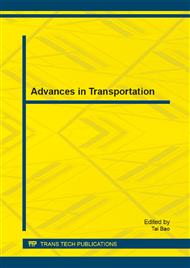p.955
p.959
p.967
p.972
p.979
p.985
p.990
p.995
p.999
An Identification Method of Traffic State Inequality for Urban Roads
Abstract:
Traffic state inequality coefficient, an index characterizing traffic state inequality for urban roads, is presented based on traffic state indexes of intersections and links calculated by traffic flow data collected from fixed traffic detectors. And then it establishes the calculation system for traffic state inequality coefficient of intersections, links and networks and determines the ways to classify traffic state inequality. After that, a case study is conducted using Vissim simulation data reproducing the process and results of the identification.
Info:
Periodical:
Pages:
979-984
Citation:
Online since:
January 2014
Authors:
Price:
Сopyright:
© 2014 Trans Tech Publications Ltd. All Rights Reserved
Share:
Citation:


